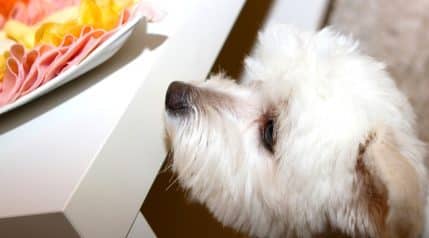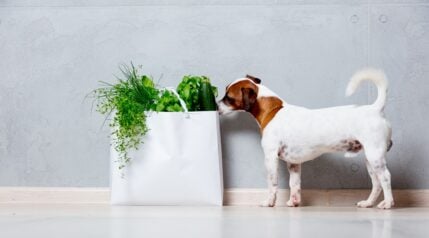Daisies are one of the most common flowers found in gardens and the wild, but also throughout childhood books, songs, and art. People have used them for thousands of years as a symbol of purity, to bring cheer to gardens and footpaths, or sometimes to eat. But not before asking them for dating advice: “She loves me? She loves me not… She loves me.”
On the other hand, our dogs are perhaps less concerned about finding love than their next snack. They are often tempted to chew on flowers, whether in the garden or out and about on a walk. And daisies are virtually everywhere. So… are daisies toxic for dogs?
The answer is not so simple since the word “daisy” can refer to many different types of flowers. And while some of these daisies are edible and should not cause any issues if munched on, others contain certain chemicals that can cause problems. Thankfully, these issues rarely cause serious concern, but there are a few things to be mindful of, so read on to find out more.

What Is A Daisy? What Does It Look Like?
The eye in the middle is where their name comes from: “day’s eye.” The most common types of daisies are the English daisy (sometimes called the “true” daisy”), the Shasta daisy, and the Oxeye daisy, though there are many others that have a yellow center and white petals.
However, the word “daisy” also widely refers to many flowers of the same family: Asteraceae. This plant family consists of over 32,000 species. The word “aster” is Greek and means “star.” This seems aptly chosen since many members of this plant family look like bright stars surrounded by rays.
Many are ornamental, but some are also cultivated for eating or medicinal properties and come in many shapes and colors. Some are very well-known flowers like marigolds, gerbera daisies, sunflowers, chamomile, and chrysanthemum. Others are cultivated in crops, such as lettuce, chicory, and artichokes. Others give us herbs such as tarragon and absinthe.
As you can see, the extended daisy family is vast and diverse.
Are Daisies Poisonous To Dogs?
When discussing whether daisies are toxic or not, it is important to clarify what we mean. Indeed, the common daisies listed above (English, Shasta, and Oxeye) are not poisonous to dogs at all. However, this is not necessarily the case for many other members of their extended family, which are also sometimes referred to as “daisies.” Many of these “cousin” plants contain compounds that cause irritation and allergic reactions in people and animals.
So, in the narrow sense of the term, common daisies are not toxic for dogs. But in the broader sense, some of their close relatives can irritate the gums and stomach, causing issues for our furry friends. And it’s not always easy to tell what’s what.
What Plants Should I Look Out For?

A few plants belonging to the broader daisy family (Asteraceae) actually look a lot like common daisies, which is why they are highlighted below. They should probably not cause any issues if the dog only eats a few flowers, but they can be toxic if eaten frequently or in large quantities, so it is good for dog parents to be aware of them.
Chamomile Family
Mayweed or chamomile also look a bit like the common daisy. These plants contain volatile and essential oils like bisabolol, anthemic acid, and tannic acid. Though they have well-renowned medicinal properties, these compounds are often bitter and irritating to the skin and gums, causing allergic reactions, vomiting, diarrhea, and sometimes even loss of appetite when eaten.
If large amounts are eaten regularly, they can reportedly even increase the bleeding tendency in the long run. However, this is not a cause for alarm in a dog who simply eats a few flowers on an occasional basis.
Daisy Mums
Though they look like daisies, daisy mums belong to the Chrysanthemum family. Like many other Asteraceae, they contain sesquiterpene lactones and pyrethrins (a chemical used to kill fleas), and other irritants. If a dog eats too many daisy mums, symptoms you might notice are drooling, vomiting, diarrhea, incoordination, and skin irritation.
Fleabane
Finally, fleabane is another close relative of the “true” daisy. It is sometimes called “Showy Daisy,” “Horseweed,” or “Seaside Daisy.” It also contains components that can irritate the mouth and stomach and inflame the skin. However, just like its relatives, it is improbable to cause serious problems.
My Dog Ate A Daisy: What Should I Do Now?

Step 1: Check Nearby Plants
Make sure daisies are the only thing your dog has chewed on or eaten. Daisies and their relatives are unlikely to cause serious or long-term issues, but other plants can, and it is important to check. See below for a list of the plants you should be most concerned about your dog chewing.
Step 2: Examine Your Dog
If he should let you check your dog’s mouth for any signs of irritation, bearing in mind, this doesn’t always show up right away. Some dogs develop irritation inside their mouth only after chewing on daisies several times. This is because some of the components inside the plant can cause progressive allergic reactions rather than an immediate one.
Step 3: Rinse Your Dog’s Mouth
If your dog seems fine, you can give him some water to drink to rinse out his mouth.
Step 4: Watch For Concerning Behaviors
Be aware that your dog might vomit. This would not be unusual after eating flowers or plants. This is not generally something to worry about too much, but if this happens, it is best to call your veterinarian to discuss what to do next.
Step 5: Call Your Vet
If your dog seems uncomfortable, you should also call your vet. In some rare instances, when dogs eat grass or plants, a small piece of plant material can get stuck at the back of their throat and make them retch and feel uncomfortable until it is removed.
Will My Dog Be Okay?
Barring any rare scenarios where a piece of a plant can occasionally stay stuck at the back of the throat and cause a lot of discomforts, it is safe to say that your dog should be absolutely fine if he eats a handful of daisies. Though some daisies can irritate the mouth or stomach, it would take a fairly large amount or repeated consumption to become a real concern in most canines.
How Do I Keep My Dog From Eating Daisies?

There is technically nothing wrong with letting your dog eat a few daisies, as they are not toxic for dogs. Occasionally biting on a few flowers should not cause any particular health issues. But, if you wish to stop this behavior, you might have to keep him on a leash in the yard until you can work with an animal behaviorist to retrain your dog. Sometimes consistently correcting with a sharp “no” when approaching the garden can be enough to change the unwanted behavior.
Frequently Asked Questions
Which flowers are poisonous to dogs?
As a rule of thumb, pet parents should steer their dog away from most bulb plants. These are usually irritating to the mouth and stomach, but some are particularly toxic, sometimes even deadly, especially if a dog gets into a large amount at once. This often happens in the fall when stashes of bulbs come out to be planted. Some examples of toxic bulb plants include, but are not limited to, tulips, hyacinths, daffodils, bluebells, crocuses (especially Autumn Crocuses), irises, dahlias, and lilies. You should call your veterinarian right away if you think your dog has eaten any part of a bulb plant.
Other than bulbs, what other plants are poisonous for dogs?
Many other plants, trees, and bushes can cause issues when eaten by a dog, usually along the lines of an upset stomach and diarrhea. The list is very long. But some are particularly dangerous as they can cause heart, liver, and kidney problems, even if only a small amount is eaten. Some of the most dangerous ones are sago palms, grapes and raisins, lily of the valley, yew, oleander, and cyclamen.
Dog parents should learn how to spot these plants and watch for them, especially when visiting a friend’s garden, as many people are not aware of which plants are dangerous for dogs and to what extent. When it comes to sago palms and grapes especially, even a tiny amount can be life-threatening, and dog parents should consider keeping their dog on a leash if these plants are around, as the consequences can be disastrous.
What happens if a dog eats a poisonous plant?
There can be serious issues if a dog eats parts of a poisonous plant. In some instances, such as with sago palms, eating even a minimal number of seeds can prove life-threatening. Many affected dogs require intensive care in a veterinary hospital for days to pull through and might have liver problems for months afterward.
In other instances, symptoms often depend on your dog’s size, the type of plant, and how much material they ate. For example, chewing on a small daffodil bulb might cause mild mouth and stomach irritation for a Labrador Retriever, while chewing and swallowing a few bulbs might cause serious heart rhythm and nervous system problems for a Chihuahua. Each case is different, and many considerations come into play.
Either way, you should call your veterinarian right away for advice if you think your dog has eaten a poisonous plant. In some instances, they might rapidly need medical attention, and it is always better to be safe than sorry.
Final Thoughts
Daisies and other members of their extensive family are everywhere in gardens, parks, and in the wild. Thankfully, most are completely harmless when eaten by a dog. Even those containing a few irritating compounds are unlikely to cause severe or long-term issues. So, while there are certainly some flowers to be on the lookout for, the daisy is a safer choice when planning your garden’s beautiful blooms.





